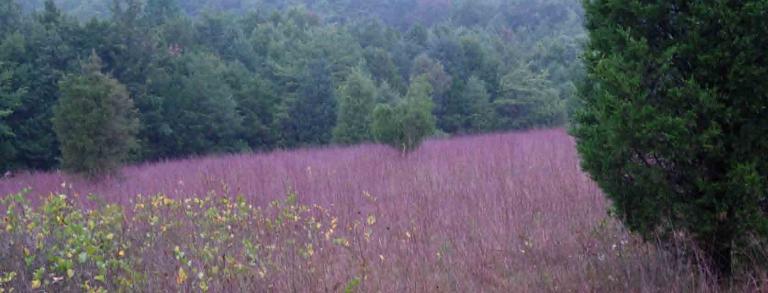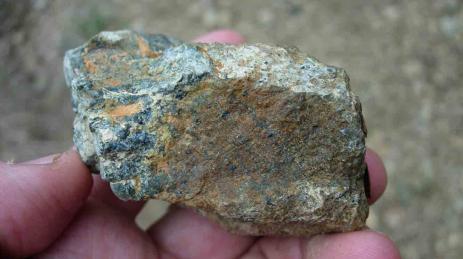IF YOU ARE interested in unusual natural habitats and are traveling to eastern Pennsylvania in the Mid-Atlantic region of the United States, you should be aware of our small cluster of serpentine barrens. This globally rare soil type results in unusual plant communities. Serpentine is a metamorphosed ultramafic type of rock that is formed when sea- floor rocks high in magnesium and iron are metamorphosed by heat and contact with seawater as continents collide. The name mafic is derived from the chemical symbol Ma for magnesium + Fe for iron. Adding the prefix ultra, of course, means they contain a very high percentage of these metals compared to most rocks. There are many outcrops of ultramafic rocks around the world, but they only make up a small percentage of the land surface of the continents. (Brooks, 1987)
In eastern North America, serpentine areas are widely scattered from Newfoundland to Georgia. These rocks were created and emplaced beginning about 480 million years ago when various small continents collided with North America and culminated about 230 million years ago when Africa arrived and finished the assembling of the supercontinent Pangaea and raising the Appalachian Mountains to heights which may have equaled the Himalaya Mountains today. Since then, erosion has nearly leveled these mountains and exposed their core rock, which includes some areas of serpentine as well as lots of other metamorphic rocks like schists, phyllites, and gneisses which are common surface rocks in the Philadelphia-Baltimore region.
There are serpentine rocks exposed at the Earth’s surface around the world. Two notable areas in the temperate zone that feature these rocks are in the Mediterranean region, especially Greece and Italy, and in Pacific-Northwestern part of North America including northern Californian and southern Oregon. In temperate climates, serpentine rocks form poorly developed soils with many rock fragments, low nutrients (especially low calcium) and poor retention capability for soluble nutrients like nitrogen (i.e., a low cation exchange capacity). Additionally, serpentine soils usually have an abundance of metals like chromium and nickel at levels that are toxic to many plants. Altogether this gives rise to a “serpentine syndrome” of particular types of plants with adaptations to survive in this harsh soil system. In places like Greece and California, where the climate has been relatively stable for hundreds of thousands of years, many endemic species of plants have evolved that are adapted to serpentine conditions. But in areas where glaciation has recently occurred, there hasn’t been enough time for such speciation to have happened yet. (Kruckberg, 2002; Latham, 1993)
In the Mid-Atlantic region serpentine barrens are found in the Baltimore area (Soldiers Delight Barrens in Baltimore County, which is the largest one at about 1340 acres, 540 hectares); along the Pennsylvania-Maryland border (southern Lancaster and Chester County, about 2100 acres, 850 hectares), collectively called the State- line Barrens, as the border literally runs through some of them; and some more small areas in central Chester and Delaware counties of southeastern Pennsylvania in the Philadelphia suburbs. Additionally, there are a few small outcrops on Staten Island, New York. The native vegetation in the Staten island sites is now lost to development and the sites in the Philadelphia suburbs are under severe development pressure and many already have had buildings built on in them recent decades. (Latham, 1993)
Dr. Roger Latham, an ecologist who specializes in grassland and “barrens” habitats of the state, has estimated from historical evidence that at the beginning of European settlement about 0.5% of the state was dominated by grasses, forbs (non-grassy flowering perennial plants), and shrubs. Most of these habitats were maintained by fires set by Native Americans (lightning rarely causes wildfires here in the humid eastern United States), probably to encourage the growth and fruiting of berry-producing shrubs like blueberries (Vaccinium sp.), elderberries (Sambucus canadensis), blackberries and raspberries (Rubus sp.) and also to improve hunting conditions by providing more tender plants for deer and other game to eat during the breeding season. These grasslands were likely a continuation of clearings made by Pleistocene megafauna like the American mastodons and giant ground sloths that lived in the area at the end of the Ice Age. They were big enough to knock down trees to get at their leaves, just as African elephants do today. In addition to serpentine, the rock underlying these grasslands includes shale, diabase and even, in a few rare cases on steep, south-facing hillsides, limestone. (Latham, 1993, 2018)
The continental glaciers stopped their southward movement about 100 miles (160 km) away in northeastern Pennsylvania, but the effect
of the colder climate was felt throughout the area and the evidence indicates that southeastern Pennsylvania was a cold grassy tundra at the time of the glacial maximum. After the continental glacier began to retreat about 18,000 years ago, trees and other vegetation began to move northward from their southern refuges, eventually colonizing the area as the climate warmed. Between 7,500 and 2,500 years before the present, the area was warmer and drier than it is now. This is called the “Great Warmth” or Hypsithermal period. During this warm and dry time many species of plants migrated from the midwestern prairies to the east coast. Now, as the climate has gotten cooler and wetter, trees have rebounded leaving serpentine barrens one of the few refuges for relict populations of many of mid-western species. (Pielou, 1991; Delcourt, 2002; Latham, 1993)
The serpentine barrens aren’t a single kind of habitat. There are forests of pitch pine (Pinus rigida) and Virginia pine (P. virginiana) usually with a thick understory of catbriar and greenbriar (Smilax rotundifolia and S. glauca), grassy savannahs with little bluestem (Schizachyrium scoparium), prairie dropseed grass (Sporobolus heterolepis), and in a few locations side-oats grama grass (Bouteloua curtipendula) and a few scattered pines or cedars still exist. A few uncommon-to-rare plants found in the grassy habitats are Appalachian groundsel (Packera anonyma; syn. Senecio anonymous) and the eponymous serpentine aster (Symphyotrichum depauperatum) which was thought to be endemic to this region’s serpentine barrens but has also been found in a few diabase barrens in North Carolina. This native aster is rather small and few- flowered, as its scientific name implies, but it makes a pleasant sight when it blooms in the autumn. It is a close relative of the midwestern Symphyotrichum parviceps and is thought to be a relict population of that species. (Hart, 1990)
There are many rocky outcrops and patches of bare rocky soil (glades) which tend to be very hot and dry in the summer and many plants exhibit water conserving adaptations such as succulent or hairy leaves. This is where some prototypical rock garden plants live, such as creeping phlox (Phlox subulata), fameflower (Phemeranthus teretifolius, syn Talinum teretifolium), rock sandwort (Minuartia michauxii), whorled milkweed (Asclepia verticillata), hairy chickweed (Cerastium velutinum), and its very hairy variety the Octoraro Creek chickweed (Cerastium velutinum var. villosissimum) which grows in just a few barrens, including rocky cliffs along the creek for which it’s named.Other notable habitats in the serpentine barrens include oak shrublands with scrub oak (Quercus ilicifolia) and blackjack oak (Quercus stellata) which are host plants for buckmoth caterpillars (Hemileuca maia) which are very spiny, stinging caterpillars that mature in the fall as large black-and-white, day-flying moths. New Jersey Tea (Ceanothus americanus) with its airy white flowers is sometimes abundant here, too. There are also many seeps and wet areas which have interesting plants, although none of them are exclusive to serpentine soils, even locally.
The serpentine barrens face many problems common to all types of wildlands, including development in this very densely populated region and invasion by weedy non-native invasive plant species; but additionally, they have a less common problem of a lack of wildfires hot enough to burn organic matter out of the soil. Our current desire to stop all wildfires, although perfectly understandable to people with nearby homes and businesses, is a big problem. Leaves and other organic matter from adjacent forests blow into barrens and over time build up until the soil’s organic layer is thick enough that it insulates invading tree seedlings from the impoverishing effect of the underlying serpentine. Normal forest succession occurs, leaving the real barrens habitat as a shrinking donut hole as the sun- loving, serpentine habitat dependent plants die and a typical eastern forest eventually covers the area. If controlled burns aren’t possible the only real alternative is scraping away soil with a bulldozer and trucking it away.
You can visit several public parks and preserves with serpentine habitat in the area. Nottingham County Park near Oxford, Pennsylvania, has some nice well-maintained trails, but check with the park office about trails, because there has been recent logging activity
to remove dead pitch pines (Pinus rigida) that were killed by a recent outbreak of southern pine-bark beetles due to recent warm winters weather failing to keep the beetles in check. Goat Hill serpentine barrens is partly on public land. It is a few miles west of Nottingham Park, Pennyslvania and is owned by the Pennsylvania Bureau of Forestry. However, the trails are very confusing and the greenbriar and catbriar (Smilax sp.) can be very thick. A GPS will help if you visit here! Sugartown Barrens at Willisbrook Preserve near Malvern, Pennsylvania, in central Chester County is owned by the Natural Land Trust (www. natlands.org). Last, but not least, Soldiers Delight near Baltimore, Maryland, is a public park and it is the largest and most diverse serpentine barrens in the region.
References:
Brooks, R. R. (1987). Serpentine and Its Vegetation, a Multidisciplinary Approach. Portland, Oregon: Dioscorides Press.
Delcourt, H. R. (2002). Forests in Peril: Tracking Deciduous Trees from Ice-Age Refuges into the Greenhouse World. Blacksburg, Virginia: The McDonald & Woodward Publishing Company. Hart, R. (1990). Aster depauperatus, A Midwestern Migrant on Eastern Serpentine Barrens?
Bartonia, 23-28. Kruckberg, A. R. (2002). Geology and Plant Life. Seattle, WA: University of Washington Press .
Latham, R. E. (1993). The Serpentine Barrens of Temperate Eastern North America: Critical Issues in the Management of Rare Species and Communities. Bartonia, The Journal of the Philadelphia Botanic Club, 61-74.
Latham, 2018 - Presentation to the Northeast Section of the Botanical Society of America at Millersville University
Pielou, E. (1991). After the Ice Age: The Return of Life to Glaciated North America. Chicago: The University of Chicago Press.


